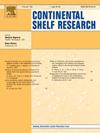Namib desert dust affects phytoplankton biomass in the Benguela upwelling region: Insights from first mesocosm study
IF 2.2
3区 地球科学
Q2 OCEANOGRAPHY
引用次数: 0
Abstract
The Benguela upwelling system (BUS) is frequently subject to dust deposition from southern Africa, which supplies macronutrients and trace metals to the ocean. The impact of these nutrients on chlorophyll-a (Chl-a) in the BUS was investigated using the first-ever mesocosm study from 29 September to October 12, 2022. The study employed a single triplicate treatment where mesocosms were seeded with dust (DG) from the Kuiseb ephemeral riverbed, one of the leading dust sources in southern Africa and one unamended control (CM). All mesocosms were also seeded with equal amounts of Chaetoceros, Pavlova, and Tetraselmis, species of phytoplankton commonly found in the BUS. Temporal dynamics in Chl-a, iron (Fe), nitrate (NO3−), silicon (Si), orthophosphate (PO43−), and light intensity were measured. The data suggests that adding dust from the Namib desert elicited a positive response from the phytoplankton in the BUS, as evidenced by higher Chl-a concentrations in the DG compared to the CM. This study demonstrates the likely importance of southern African dust emission and deposition for phytoplankton productivity in the adjacent BUS.
纳米布沙漠尘埃影响本格拉上升流区浮游植物生物量:来自首次中生态研究的见解
本格拉上升流系统(BUS)经常受到来自南部非洲的尘埃沉积的影响,这些尘埃向海洋提供大量营养物质和微量金属。在2022年9月29日至10月12日进行了首次中尺度研究,研究了这些营养物质对叶绿素-a (Chl-a)的影响。该研究采用了一种单一的三次重复处理,其中中生态系统播种了来自Kuiseb短暂河床的粉尘(DG),这是非洲南部主要的粉尘来源之一,也是一种未经修正的对照(CM)。在所有中生态系统中也播种了等量的毛囊、巴夫洛瓦和四足类浮游植物,这些浮游植物通常在BUS中发现。测量了Chl-a、铁(Fe)、硝酸盐(NO3−)、硅(Si)、正磷酸盐(PO43−)和光强的时间动态。数据表明,添加来自纳米布沙漠的尘埃引起了BUS中浮游植物的积极反应,这一点从DG中比CM中更高的Chl-a浓度得到了证明。这项研究表明,南部非洲的粉尘排放和沉积对邻近BUS的浮游植物生产力可能具有重要意义。
本文章由计算机程序翻译,如有差异,请以英文原文为准。
求助全文
约1分钟内获得全文
求助全文
来源期刊

Continental Shelf Research
地学-海洋学
CiteScore
4.30
自引率
4.30%
发文量
136
审稿时长
6.1 months
期刊介绍:
Continental Shelf Research publishes articles dealing with the biological, chemical, geological and physical oceanography of the shallow marine environment, from coastal and estuarine waters out to the shelf break. The continental shelf is a critical environment within the land-ocean continuum, and many processes, functions and problems in the continental shelf are driven by terrestrial inputs transported through the rivers and estuaries to the coastal and continental shelf areas. Manuscripts that deal with these topics must make a clear link to the continental shelf. Examples of research areas include:
Physical sedimentology and geomorphology
Geochemistry of the coastal ocean (inorganic and organic)
Marine environment and anthropogenic effects
Interaction of physical dynamics with natural and manmade shoreline features
Benthic, phytoplankton and zooplankton ecology
Coastal water and sediment quality, and ecosystem health
Benthic-pelagic coupling (physical and biogeochemical)
Interactions between physical dynamics (waves, currents, mixing, etc.) and biogeochemical cycles
Estuarine, coastal and shelf sea modelling and process studies.
 求助内容:
求助内容: 应助结果提醒方式:
应助结果提醒方式:


